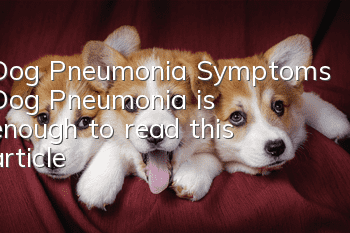Dog Pneumonia Symptoms Dog Pneumonia is enough to read this article!

Foreword:
Because the current air quality is not good, it is easy to cause respiratory diseases, and dogs are also prone to pneumonia. So what are the causes of pneumonia in dogs, what are the symptoms of pneumonia in dogs, and how to treat pneumonia in dogs?
2. Inhaling irritating gases, soot or accidentally ingesting foreign objects that enter the lungs.
On auscultation of the lungs, alveolar sounds are reduced in the diseased areas, crepitus can be heard, and sounds can be heard in healthy areas.
Blood changes, the total number of white blood cells and neutrophils increased, and there was left nuclear shift. X-ray examination shows that the lung texture is thickened and has flaky shadows.
(4) Fatan antitussive, ammonium chloride 50 mg/kg body weight, Kebiqing 2.5 mg/kg body weight, taken orally 2 times a day. To relieve asthma, aminophylline 10-15 mg/kg body weight can be taken orally 2 times a day.
Because the current air quality is not good, it is easy to cause respiratory diseases, and dogs are also prone to pneumonia. So what are the causes of pneumonia in dogs, what are the symptoms of pneumonia in dogs, and how to treat pneumonia in dogs?
Causes of pneumonia in dogs
1. Because of colds and dirty air , poor ventilation, overwork, lack of vitamins in the body, leading to respiratory infections and reduced body resistance, causing microorganisms (staphylococci, streptococci, Escherichia coli, Klebsiella and molds, etc.) in the respiratory tract or outside the body to pass over a period of time. After an incubation period, the disease attacks and the animals are attacked by the virus.2. Inhaling irritating gases, soot or accidentally ingesting foreign objects that enter the lungs.
3. Persistent factors, such as bronchitis, influenza, canine distemper, or parasites, such as paragonimiasis, Toxoplasma gondii, and roundworm larvae, may cause pneumonia.
Symptoms of pneumonia in dogs
The disease initially presents with symptoms of acute bronchitis, including runny nose, dry cough, and bronchial sounds. As the disease progresses, the general condition worsens, the spirit becomes depressed, the appetite decreases or no food is eaten, the body temperature rises to 39.54 degrees, the symptoms are flaccid fever, dyspnea, increased frequency, conjunctival cyanosis, sunken eyeballs, and dehydration.On auscultation of the lungs, alveolar sounds are reduced in the diseased areas, crepitus can be heard, and sounds can be heard in healthy areas.
Blood changes, the total number of white blood cells and neutrophils increased, and there was left nuclear shift. X-ray examination shows that the lung texture is thickened and has flaky shadows.
Treatment of dog pneumonia
(1) Penicillin 50,000 units/kg body weight, streptomycin 30,000 units/kg body weight, dexamethasone 0.1-0.3 mg/kg Body weight, mixed and injected intramuscularly, 2 times/day, for 5-7 days.(2) Tetracycline 10-15 mg/kg body weight, dissolved in 5% glucose, intravenously injected twice a day. Or a combination of 56 mg/kg body weight of Shochuangmycin and 0.2 mg/kg of dexamethasone for intramuscular injection twice a day.
(3) Supportive therapy, 5% glucose saline 15-30 ml/kg body weight, 5% sodium bicarbonate injection 1-2 ml/kg body weight, mixed intravenous infusion.(4) Fatan antitussive, ammonium chloride 50 mg/kg body weight, Kebiqing 2.5 mg/kg body weight, taken orally 2 times a day. To relieve asthma, aminophylline 10-15 mg/kg body weight can be taken orally 2 times a day.
(5) Oral ephedrine should be taken in case of dyspnea and heart failure. 5-15 mg each time. Aminophylline, 10 mg/kg body weight, taken every 8 hours. Hypoxia due to dyspnea should be treated with inhaled oxygen. Anorexia, intravenous injection to replenish body fluids and nutrients.
Random articles
- Early symptoms of pancreatitis in dogs
- Puppy Skeletal Development—Feeding Guide
- Chinese turtle characteristics_habits_breeding_how much does it cost-neighbor’s pet
- Three things to note when buying a purebred golden retriever
- What to do if a spaniel goes into shock
- What types of jobs do Labradors have? Several diseases Labradors are susceptible to and their feeding methods
- Dog diarrhea with blood
- How to fix a dog’s fracture?
- Nova Scotia Duck Hunting Retriever Information_Scottish Duck Hunting Retriever Price
- What’s wrong with red and swollen dog toes?



